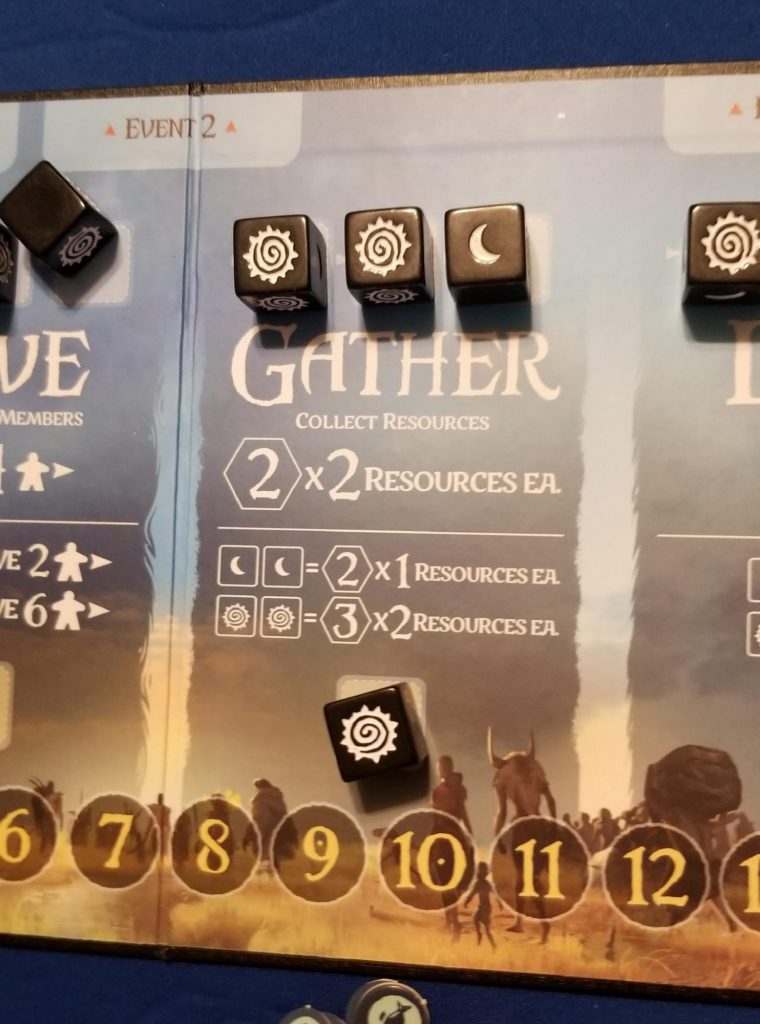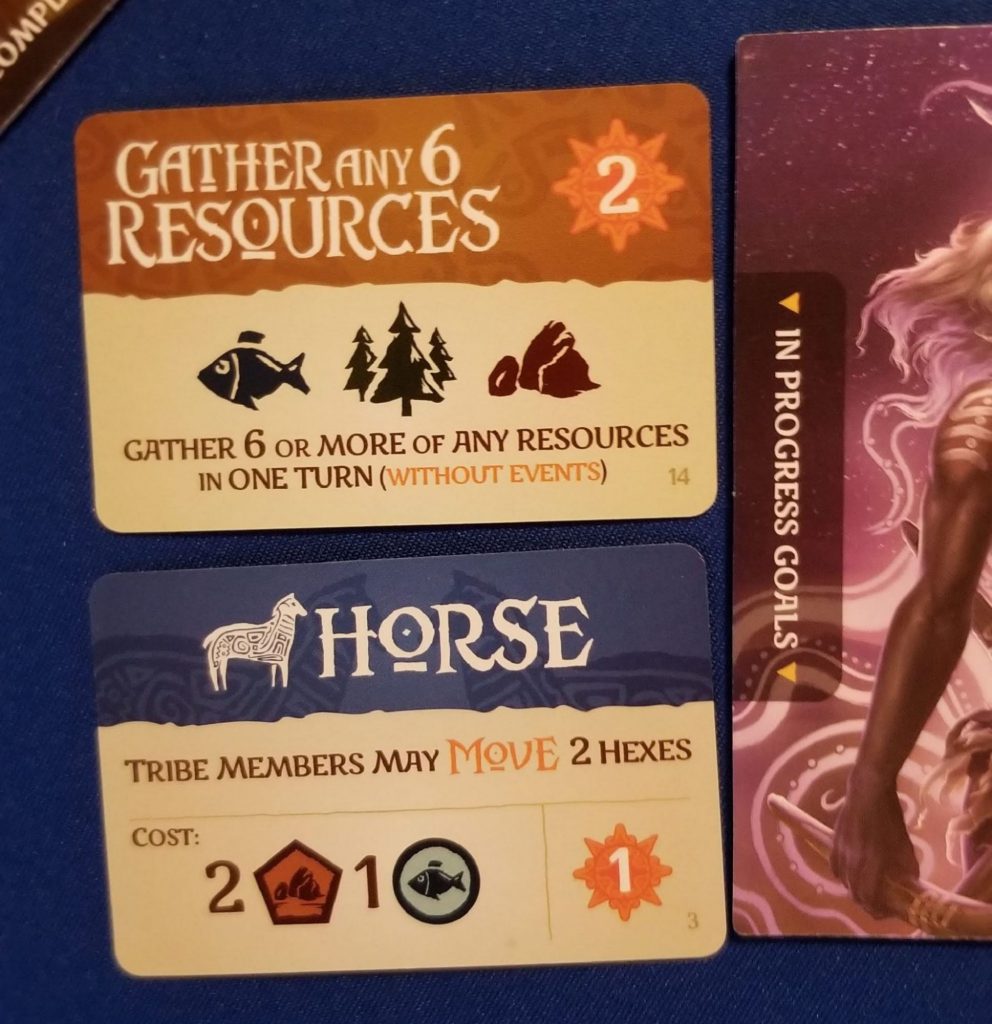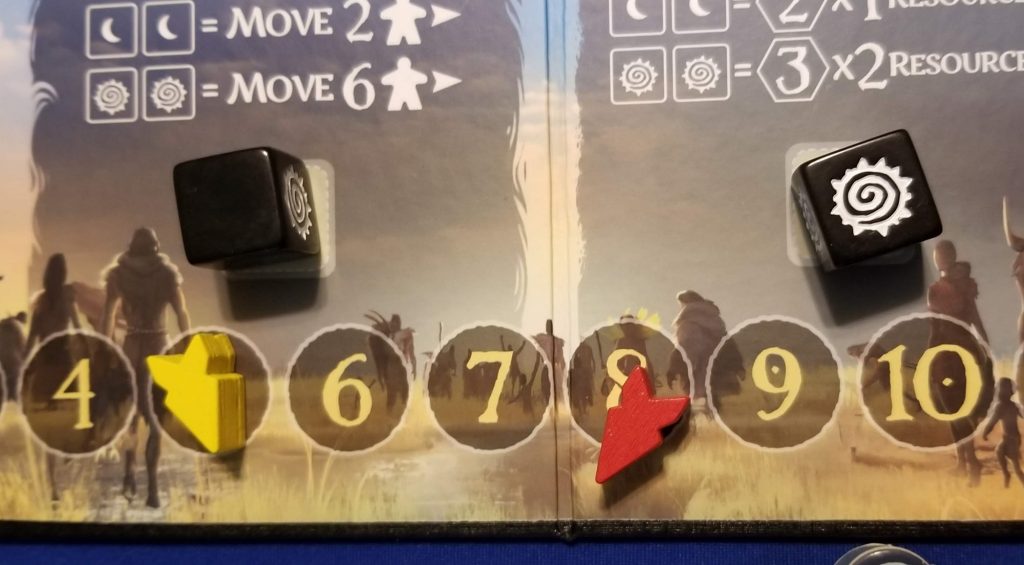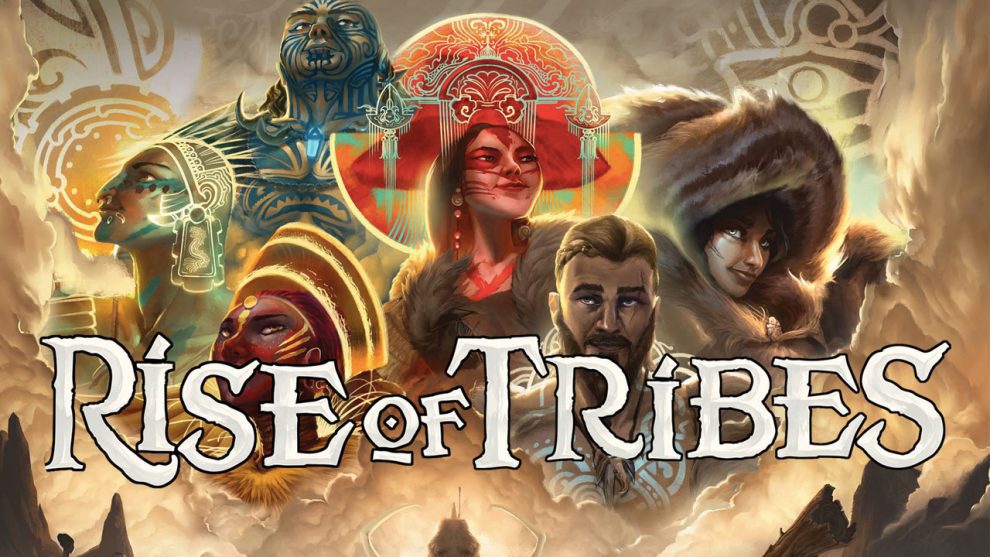Disclosure: Meeple Mountain received a free copy of this product in exchange for an honest, unbiased review. This review is not intended to be an endorsement.
Overview
In Rise of Tribes, each player takes control of a prehistoric tribal faction as they use their dice actions to grow and expand across the land, competing for scarce resources. As these resources are collected, the players utilize them to establish villages, research new technologies, and score points. The first player to reach 15 points wins the game.
If you’re just interested in hearing what I think about Rise of Tribes, feel free to skip ahead to the Thoughts section. For those of you who want to know more about how the game is played…
Setup
First, the game tiles are shuffled and a number of these (determined by player count) are drawn and placed into a specific spatial arrangement to form the playing area. Close to this is placed the game board.
Next, the Event tiles deck is shuffled and placed face down into the appropriate area above the board and each action is seeded with three dice apiece in this configuration: sun, moon, and blank. Each player selects a color and a faction to play with and takes the appropriate faction board and playing pieces. Their victory point (VP) tracker is set onto the 0 space of the VP track. Their Goal cards are shuffled into a face down deck and placed beneath their playing area with their tribe members close by. All of the other tiles (resource chits, village tiles, and the tiles used with some of the events) are set off to the side.

A start player is selected and they will place some of their tribe members onto the board followed by the other players in turn order. Each subsequent player will be able to place more tribe members than the previous players were able to. Now you’re ready to dive in!
Rolling the Bones
Central to Rise of Tribes is the clever dice placement system. On a player’s turn, they will roll 2 dice and then assign each die to different actions. Each of the 4 different actions has 3 spaces sitting directly above it that are able to accommodate 3 dice. When a die is assigned to an action, it is added to the left of the existing dice causing the die on the right to fall off. These dice have 3 different faces that they could display: sun, moon, or blank. The efficiency of any chosen action is directly affected by which die faces are showing when the action is selected. So, not only are you setting up your own turn during this phase, you are also setting up your opponents for theirs.

Taking Action
There are four different actions available to you in Rise of Tribes: Grow, Move, Gather, and Lead. Grow allows you to add tribe members from your supply to the playing area. Move allows you to move existing tribe members around the playing area in order to establish presence on tiles. Gather allows you to gain resources from some of the tiles which you have established presence on. Lead allows you to draw Goal cards from your deck and place them into your “In Progress Goals” area to the left of your player board.

As stated earlier, the effectiveness of these actions will change depending on the dice that are present when the action is taken. For example, the Grow action allows you to add 4 tribe members to the playing area if there are 2 suns present but only 2 if there are double moons. The basic Grow action allows you to add 3 if neither of those other two conditions are true. As a free action, players can also construct villages on their turn. The cost associated with doing so will differ depending on the faction that they selected. These villages will earn them VP at the start of their turns as well as allowing them to cycle through their Goal cards faster during Lead actions.
Event Horizon
Events only come out when a player rolls doubles. When this occurs, an Event tile is drawn from the deck and placed into one of the two available Event slots above the game board if there is an empty slot available. These events will always change the game in some fundamental way. Some examples are events that allow players to gather additional resources during a Gather action or provide the players with additional ways to score VP.

It’s Always Good to Have Goals
Achieving the goals on your Goal cards is the primary method of scoring VP in Rise of Tribes. Regardless of the goal, you will always earn something for achieving it. Some goals will provide the player with benefits that last throughout the entire game (extra movement per Move action, for instance) while others will score them points for meeting certain criteria such as having the majority (most tribe members present) on a certain number and/or type of tiles. Whenever a goal is completed, the card is moved to the “Completed Goals” area to the right of the player board and the points are scored immediately.

Thoughts
There are a lot of things that I like about Rise of Tribes and very few that I don’t. As far as the negatives go, the one thing about Rise of Tribes that bothers me the most is the resource chits. They’re very tiny and hard to manage. I don’t understand why the publishers chose to go this particular route instead of providing more tactile solutions like wooden resources or even different colored crystals. They’re just very weird and people have made comments to that effect literally every time the game hits the table. Another minor issue that I found strange was that the rule book never explains what the orange splat symbol all over the various cards is. I was able to deduce that it was the icon for VP, but it seems odd that it was never explicitly mentioned anywhere.

It always bothers me when a game that utilizes dice doesn’t provide any kind of mitigation. Rise of Tribes is one of these games. There are no options to re-roll. There are no technologies that you can research that will have any bearing on your dice rolls. You’re at the mercy of whatever fate decides to provide you with. Fortunately, in Rise of Tribes it never feels like this aspect hurts you too much. I am always able to do something useful even if it isn’t particularly effective.
Another thing of note is that, while Rise of Tribes can be played as a two-player game, it definitely feels much better at a higher player count. In my two-player experiences, there wasn’t much competition for resources and when there was, it was very difficult to dislodge another person from their holdings due to turtling – staying in one small area and amassing forces. In a higher player count, it’s much harder to turtle because the playing area is much more full which forces a lot of conflict.
And speaking of conflict: Rise of Tribes has one of the fairest and most enjoyable conflict resolution systems I have ever come across in any board game. Typically these kinds of things are handled by dice roll offs or card draws and I can’t stand that. The idea that I could move into a space with vastly superior numbers and be wiped off of the map because the other person rolled dice better than me just seems unfair and distasteful. Well, Rise of Tribes handles conflict in a much more strategic way. If there are ever more than 5 tribe members present on a space, a conflict is triggered. Players take turns removing their tribe members at a 1:1 ratio until there is only one color of tribe member left. It’s fast. It’s simple. And it means that you can always plan for the outcome. I love it.

Rise of Tribes is a race game and that brings a lot of interesting tension to the table as you’re forced to choose between scoring points for yourself or trying to hamstring your opponents. If you focus too much on your own game, there’s a good chance that one of your opponents is going to gain some advantage that is going to rocket them along the VP track when you’re not paying attention. How do you balance your own self-improvement with the need to stop your opponents? There’s no right or wrong solution, but it definitely presents an interesting challenge. Rise of Tribes never leaves me feeling disconnected from the experience and I quite like that.
With the exception of the resource chits, Rise of Tribes has some great component quality. The cardboard is nice and thick. The cards have a good snap to them. The wooden bits are sturdy and attractive. The meeples for each of the different tribes even have their own unique shape! How cool is that?! And the artwork is just… wow. Sergio Chaves’s illustrations really help bring the game to life. All of these things put together provide Rise of Tribes with an undeniable table presence. Even the box insert is phenomenal.

Rise of Tribes is a game that demands your attention and refuses to be ignored. I can tell you from personal experience that you’d be wise to heed its call. I have thoroughly enjoyed my time with this game and I think that you will enjoy yours as well.












I am very confused by the final score after reading the review.
Is this a mistake?
I just re-read what I wrote, and nowhere in my review did I ever present an example of scoring. I’m not sure what’s got you confused. Can you provide more specifics?
Sorry, I meant the final score:
AUTHOR RATING
Mediocre – I probably won’t remember playing this in a year.
I felt the vibe of the review was mostly positive, so I didn’t except a 2,5 stars.
Compared to the last paragraph for example:
“Rise of Tribes is a game that demands your attention and refuses to be ignored. I can tell you from personal experience that you’d be wise to heed its call. I have thoroughly enjoyed my time with this game and I think that you will enjoy yours as well.”